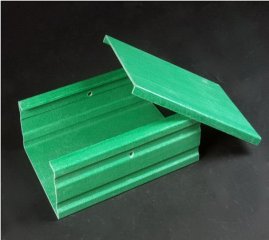Brief introduction
FRP cable tray (also known as FRP cable tube box or polyester glass fiber cable box) is formed by a molding of high flame retardant polyester, high density glass fiber and high strength new materials. FRP cable tube has features of good insulation, high strength, corrosion resistance, acid and alkali resistance, anti-aging, fire and flame retardant and environmental adaptability (- 50 60 C), non-toxic, tasteless, light weight. (Generally only 1/4 of the weight of steel cable tray and 1/10 of the weight of cement cable tray), which makes it is easy to install, low cost, long service life, and anti-theft function. Each technical data of Fiberglass cable tray meets the relevant technical requirements of JT/T599.2-2004 “Glass Fiber Reinforced Plastic Products for Highway” and the Quality Supervision and Inspection Center of Railway Department. It is especially suitable for the construction of expressway, railway, tunnel, electric power, petroleum, chemical industry, municipal government and other projects.
Installation of FRP cable tray (fiberglass polyester cable tray):
- Before installing cable tray, bracket is installed on cable bridge. The size of bracket depends on the specification of cable tray, but the spacing should not be more than 1500mm. It is usually made of angle steel.
- Place the FRP cable box on the bracket. Once the position of the bracket is determined, the cable tray and the bracket can be drilled through with a hand electric drill. Then the bracket can be tightened with bolts. Two holes are drilled on each bracket with a diameter of 10mm and two sets of M8 bolts are used.
- Socket joints and seam covers shall be used at the joints of Fiberglass cable trunking to connect the two sections of cable boxes into a whole.
- Concrete pipe or steel pipe can be used for the connection between cable box and subgrade cable.
- The bend of the road is connected with the elbow of the FRP cable trunking.
- The lid and the box body are fixed with plastic bolts and stainless steel bolts.





























